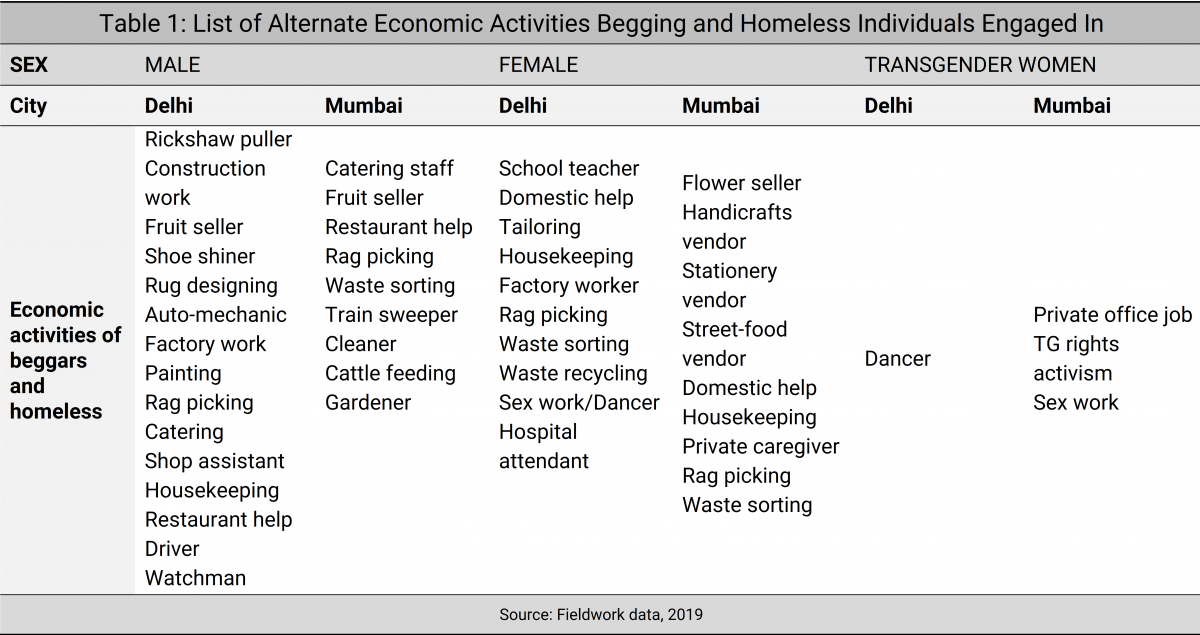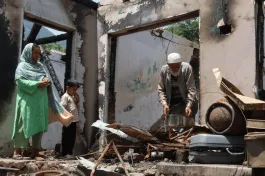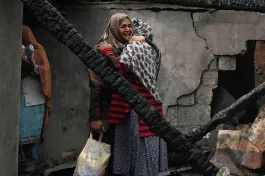People usually view begging with a fair amount of moral ambiguity and suspicion. Questions are asked about the long-term implications of a “culture” of living on the dole or by manipulating public sympathy. Beggars are subjected to a spectrum of negative responses from passers-by seeing them as “non-persons” to the state using anti-begging laws to arrest and institutionalise them. A common observation against the poor who beg seems to be: “Why can’t they work instead of begging?” Or that there is a huge network of organised criminals behind the beggars.
The rhetoric around begging is marked by the objectification of individuals who beg. That is, we see beggars as inanimate objects who need not register in our consciousness. This then allows them to be dehumanised in our minds. As a researcher who has engaged with begging populations both in their community and custodial settings, here I illustrate the unconventional employment histories of beggars and the rationale they provide for the times when they choose begging over other forms of paid labour. Exploring the factors that lead them to this unique occupation is one of the many ways in which we can understand the phenomenon of begging, and humanise the conversation about those who beg for a living.
Beggars migrate from other forms of economic activity
Migration from the rural to the urban underlies much of the process of urbanisation in Indian cities. While rural–urban economic migration is a well-documented process, the nature of occupations, job shifting patterns, and the lived experience of the most marginalised of our urban population are less well known. The beggars in our cities belong to this neglected demographic that is ironically also the most visible section of the population on the busy metropolitan landscape.
A majority of the ... participants who begged and/or were homeless had engaged in economic activities other than begging when they first migrated to the city.
The data from my doctoral study on begging in Delhi and Mumbai indicate that most people who beg held multiple jobs before they turned to begging. Notwithstanding the small ethnographic sample, it must be mentioned here that 70 per cent of the participants in the study (29 out of the 41 persons interviewed) who were begging and homeless had also engaged in marginal forms of economic activity at some point in their lives. This was as true of men as of women – including transgender women – and of both able-bodied persons as well as those with disabilities. Some still engaged intermittently in daily wage labour to supplement their income from begging. It was found that despite facing severe social ostracism and having limited livelihood opportunities open to them, transgender women in the cities even attempted to find jobs in the formal economy.
A majority of the study participants who begged and/or were homeless had engaged in economic activities other than begging when they first migrated to the city. Rag picking, an activity that includes urban waste sorting, recycling and reselling, is one of the most common low-skilled economic options available for homeless individuals. Both men and women who begged in the two cities had often been associated with the low end of the waste management industry at some point in their lives. There are various levels to the waste disposal and management system of which rag picking is the least desirable end of the spectrum. But since like begging it is an activity that does not require education or skills, it is one of the most frequently chosen forms of work. Some also worked at other levels of this waste management system such as owning small shops that collect post-consumer waste to be resold and recycled. It is important to note here that although the anti-begging laws do not make such a definitional distinction, not everyone who is homeless is necessarily a beggar. Not everyone who begged was also homeless in the city. Some had homes or rented accommodation often located at the outskirts of the main city, or in temporary jhuggi settlements that Indian cities are dotted with.
Other usual income generating options available to the urban poor include domestic help, housekeeping, and private caregiving roles for women, and catering services for men. Rickshaw pulling and daily-wage construction labour was also quite common among homeless men in Delhi. Some also engaged in fruit selling or hawking small inexpensive articles for sale on the streets and pavements. But all such work required working capital and was not sustainable in the long run due to the precarity associated with street life. An indicative list of the various forms of street work and economic activities that begging and homeless individuals were found to have been engaged in is provided in Table 1. There were also instances of individuals with varied levels of education (primary, secondary and pre-university), and training or skills (industrial training and nursing, for instance) who now relied on begging because they could no longer work because of old age, substance use, disability or just lack of support.
Disability and absence of supported employment
The disabled poor in India face additional attitudinal barriers, besides physical and financial ones. This limits their access to education and employment, leading to further social and economic exclusion. Hence, it is not difficult to understand why many of them are compelled to turn to begging. In the National Capital Region, for instance, persons with disability constituted a large proportion of the begging population: of the 2,054 persons classified as “beggars, vagrants, etc.” 583 (28.38%) were persons with disability (Census of India 2011). Moreover, the general public tends to treat disability among the poor as further evidence of their association with criminality. It is unfortunately extremely common for the elite and middle-class urban public to express views that stigmatise poor and disabled individuals by holding them responsible for their own disability. They base these views on superstitious beliefs about paying for sins committed in past lives. Worse still, they think that the poor deliberately inflict self-harm, and impair themselves in order to gain public sympathies and get rich.
In the absence of adequate welfare, begging in fact becomes a viable source of income for people with disabilities.
Assuming that there is some truth to this construction, the fact that little consideration is given to circumstances that may necessitate such desperate responses for survival, exposes the generally apathetic nature of our engagement with begging. The evidence from the field, however, suggests that nothing could be further from the truth. In the absence of adequate welfare, begging in fact becomes a viable source of income for people with disabilities. In his work on begging among people experiencing mobility difficulties in Ghana, where begging is outlawed as well, Kassah (2008) explains how by considering begging as a legitimate form of work, individuals are able to minimise their experiences of shame and exclusion that they face from an early age owing to their disabilities, and cope with stigma by finding acceptance among equals in the community.
Ahmed, a 37-year-old disabled man from Uttarakhand, who begged at Nizamuddin in Delhi, complained about the lack of government support in his home state for the poor who like him had to live with disability since early childhood. Though he would have preferred decent work or some form of supported employment, its absence left him with no choice but to beg:
Nothing at all…nobody ever gave me a thing till this day. Nor did they gave me that rickshaw, that vehicle for the handicapped…I’ve the certificate too. I didn’t get it in Uttarakhand. My legs are bad since I was a child... They gave me nothing! And to make matters worse, they also stopped the disability pension that we used to get. Those 1000-2000 rupees that were too little even for us, they would gobble that up too. Now you tell me what can one do?
Ahmed could not make sense of the state corruption in the disbursal of the disability pension. According to the website of the Government of Uttarakhand, the pension is Rs. 1000/- per month. 1 According to information provided on the Social Welfare Department website of the Uttarakhand Government, under the “Divyang Pension Scheme” members of families that are residents of the state and deemed BPL, aged 18-59 years, either with 80 per cent disability or with multiple disabilities, are entitled to receive a pension of Rs. 1000 a month. This is a fusion of the state government’s support with the Indira Gandhi National Disability Pension Scheme (IGNDPS). The state contribution is Rs. 700 and the IGNDPS contribution is Rs 300 every month. (http://socialwelfare.uk.gov.in/pages/display/96-disability-pension last accessed on 05-11-2018) To be eligible for this meagre amount, the disabled poor who are often barely literate have to negotiate an insensitive bureaucracy and procure required documentation. Yet, in the end, petty corruption by the bureaucracy seems to deprive them of even the small allowances that they are entitled to. Begging thus becomes a survival strategy for the doubly marginalised disabled poor, who, despite their best efforts, are unable to overcome the many impediments that the state places on their path to realise their basic rights.

Sexual harassment at workplace against women factory workers
Radha, a 45-year-old disabled woman, migrated from Darbhanga in Bihar to Delhi in search of employment after her construction-worker husband met with an on-site accident that left him badly injured and unemployable. In spite of her own disability, she went looking for jobs and worked at multiple factories around Delhi, including in footwear, electrical switch making, pharmaceuticals and packaging. At some of these workplaces, she faced the threat of sexual harassment coupled with discrimination for being a “Bihari”, while at some others she realised that her productivity and employability were limited by her illiteracy.
I used to go there… near Moti Nagar. Then, I used to work in a factory that manufactured slippers. So what happened in that factory was that a man came from the neighbouring workshop and said, ‘Brother, send a couple of these ladies looking for work over to ours as well…?’ The man at our factory replies, ‘Okay!’ Then the other guy says, ‘Over here though we don’t work with women; we only have women around to pass time.’ The man at our factory tries to reason with him saying, ‘Brother, she has no interest in passing time; she is only interested in doing her job.’ But the other guy kept insisting saying, ‘Women are around for us to have fun with; they are for our entertainment…’ Finally I said, ‘To hell with your factory!’ I left that job in the slippers factory. After that I kept wandering looking for another job because I had to pay my rent. I was at the wrong place, I thought. They were looking for the wrong type of people. This is all after I broke my leg. I worked there only for a few days.
Radha then goes on to describe of her unsuccessful attempts at finding suitable employment:
Then I went to a switch factory, Rama Road. There was this other woman, wearing lipstick, cream all over her face, here, here, everywhere, with a handbag, watch, her slippers, worse than mine! She too came along on the same truck as me to look for work. There at the factory office, they had this glass door. The supervisor sees us waiting and asks, ‘Why are these women sitting here?’ I say, ‘For work.’ So he turns to me and says, ‘Yes miss, so what’s the fuss about?’ I explain, ‘I came looking for work. This board here says you’re hiring. So I came to inquire because I need a job.’ Then the other guy in the office remarks, ‘Oh man, she is a Bihari. This one is not gonna work!’ So they got rid of me and gave the job to that other “handbag lady”.
Here Radha is dramatising the narration of her experience to add humour, but also to suggest that her rejection was unfair and arbitrary. Even after facing sexual harassment and discrimination, she persisted and worked at a pharmaceutical manufacturing and packaging factory in Delhi for sometime. However, being uneducated proved to be a major hurdle for her upward mobility despite her hard work and determination. She found it difficult to sort and package drugs without help, and she was also aware of the potential risks of mismatching drugs and labels. Eventually, she had to give up the job.
I had a certificate…ration card, voter ID, Aadhaar card, all of it… Then some people told me, ‘Get disability certificate, you will get service then, or they might allow you to run a shop…that way you can raise your children.’…I went to Ajay Maken. He’d be there in his office but his subordinate wouldn’t let me meet him. He’d say, ‘No, no…get out of the way, go out!’ There too I got pushed around. There I couldn’t get a hearing. Next I went to India Gate, to Shelja Kumari. I didn’t get a hearing there either. Then I went to Sheila Dixit, where they didn’t see me. Then I went to Sonia Gandhi. Same story. I did this for seven long years. Then I went to Mukul Wasnik, Tughlaq Road, House no. 6 – I even remember the house number. I remember all the ministers’ addresses, which one lives where – there too I got thrown out. Not a single minister gave me a hearing: neither did they give me a job, nor a shop to earn a living.
Being a disabled woman, she also spent seven years outside various government offices seeking state support in order to become gainfully employed, before she resorted to begging. Most women who beg complain of the callousness and indifference of the government authorities to their plight which eventually pushes them deeper into the vicious cycle of vulnerability and protracted impoverishment: “Mera koi saab bhi soonwaayi nahin kiya…” [“Not a single official gave me a hearing”]. Women also complained about the casual apathy of the police who do not bother with their life and safety as they are perpetually exposed to everyday sexual violence and street-level harassment.
For most beggars then, begging was not an enthusiastic choice, as is commonly believed. However, once they found themselves begging, they came to see it as viable means of earning a livelihood given their circumstances. It became a way to improve their own or their families’ living conditions, including meeting educational needs and providing opportunities for their children. Radha explains:
My boys, one of them is in college. Of the other two, one is in class 12 and the younger, in class 11. They go for tuitions; one is learning computers…all by the grace of God, with my pleas – “babu!”, “bhaiya!”, “madam!” – I’m managing my living. I’ve rented a room; I’m eating and drinking right: no intoxicants, no substances. And my children, they are good too…they don’t have any of these bad habits…they are so decent. But I’m not able to give them time. […] When I started making my living from this place, I told myself that all the ministers could go burn in hell! I stopped going to their houses…I still have this huge stack of papers that I filed in all their offices…None of them gave me a hearing. Otherwise I don’t like to beg either. Even today if someone were to offer me a stall to run somewhere, I’d stop begging.
Radha’s persistent but futile attempts at finding work in the face of harassment and apathy by the administration are evidences of how desperately the poor seek to be gainfully employed, rather than be beggars. Thus, far from being a “lifestyle choice”, begging is often a choice among equally undesirable non-choices.
Old age and begging as ‘retirement’
Begging also becomes a survival strategy for skilled and unskilled workers in their old age when they are no longer able to work, and do not have adequate pensions or family support to meet their needs. The elderly population too is in need of care and state welfare but is rarely the focus of intervention for policymakers. As such they are yet another set of people at risk because they lack adequate social security.
My study found several instances of individuals who had left home for good quite early on in their lives, to never go back. They fell out of touch with their families and remained totally disconnected with their kin networks until their old age. Some people were also abandoned in their old age by relatives who saw them as a burden and could not afford their health and caregiving needs. Begging for all such individuals became a way to sustain themselves in the city through the winter of their lives.
A few of the elderly participants who begged were somewhat educated and had certain professional skills, some with many years of experience in their respective fields. Eighty-year-old Hussein was one such person. He had left home as a boy because of problems with his family. He trained himself in auto-engineering and worked in various cities in India. He had remained single and had lost all contact with his family. Now with ill health, a frail memory and rapidly deteriorating hearing and eyesight, he could no longer perform hard labour. He had not bothered to save money or buy a home. He lived in a homeless shelter in Nizamuddin, Delhi, surviving on the bare minimums as a “faqir”. 2 Almost a year or so after his interview with me, Hussein passed away. He was liked and respected by the shelter authorities. Though he did not seem to want to maintain any ties with his kin, according to the caretaker of the Nizamuddin shelter a sister of his was intimated about his demise. He said that he had travelled a lot for work and had a fulfilling and eventful life as a truly self-made man:
I used to work at an auto engineering company; in auto engineering, I did boring, polishing, crank turning, rod turning, smelting, these are all English words…then I went into mechanical. I’m not just someone who learned how to work the crank saw, connecting rod, etc., but I’m sitting here before you as someone who has also worked everywhere in India. It all started in Kanpur in 1958. I’m from Kanpur main city... […] Then I came to Delhi and worked in bicycle painting. I left that job after two years and came to Ajmere Gate. There I learned spray painting and colour mixing. Those days in cycle painting, we only used just one colour; black…I’m talking 50-60 years ago! … Thereafter, I came to Hari Nagar at Ashram and worked for 5 years in the factory…
He laughs to himself as if in reflection and continues:
Hari Nagar is at Ashram…there used to be a New Light Engineering Corporation, a supplier and manufacturer of scientific equipment. So they also needed painting for scientific equipment. They used to make stands etc., petrol lamps made of brass and magnets…So I worked there for a year. Then I got tired of Delhi. Meanwhile, I had already been to Bombay a couple of times. There I used to work at a motor oil company. Now these companies have changed, some closed… painting, A-Z, I’ve done it all. I’m an artist, I used to make pictures, and I was a stenciler; I could do a cut out and make a rose if you wished on your hand. I also used to do geometrical art; I’m familiar with a whole lot of geometry and measurement of angles etc. because of that. So, I’ve worked a lot in my life…
Relatively, his was sort of a “success story” in terms of those who set out to make it on their own. Hussein now hoped to lead the life of a hermit in and around Nizamuddin.
Now, let’s see, it’s been like 10 years probably, that I’ve become redundant…I have got ear problems, poor eyesight; I’m also hard of hearing, I find it hard to recognise people.
Though Hussein relied on the kindness of his acquaintances and benefactors, he said he did not beg. He only received whatever gifts people willingly offered him out of love and of respect for his age. Places of worship provided a safe space for the elderly poor like Hussein, who fashioned their identities not as beggars, but rather as “faqirs,” an Arabic term that refers to mostly a Sufi Muslim (sometimes Hindu) ascetic who renunciates worldliness to live a life of bare minimums and piety, and wait on God to be merciful upon arrival of the day of judgment.
Among women who took to begging in their old age, some had worked as domestic help, nurses and caregivers for affluent urban families.
The word itself is derived from the Arabic word faqr that literally translates to poverty, destitution and pauperism. According to Nicholson (1914), a faqir does not beg unless he/she is starving, and when compelled by circumstances, does not take more than what he/she needs. In fact, the tenet of being a true faqir also prohibits the poor from making God an excuse to solicit alms. However, it does allow them to receive what is voluntarily offered: “it is the daily bread which God sends to you: do not refuse God’s gifts” (Sufi maxim cited in Nicholson, 1914, p. 27). Many such individuals had regular donors, with whom they shared a relationship that they did not merely perceive as transactional, but rather a transcendental one, involving friendship, kindness and goodwill in the name of all that was divine.
Among women who took to begging in their old age, some had worked as domestic help, nurses and caregivers for affluent urban families. For instance, 63-year-old Amba, an inmate at the Beggar Home in Chembur, Mumbai was homeless, as her son and daughter-in-law had abandoned her. Throughout her life, she had worked as a caregiver in the homes of several veteran actors of the Indian film industry until a road accident left her with a permanent leg injury in her old age.
When asked about why he chose to beg at the Nizamuddin Dargah in Delhi, one of the beggars I interviewed poignantly responded: “After all, where do the poor in Delhi go when they retire…? Nizamuddin!”
According to him Nizamuddin was the place where all the poor who beg would go after their “retirement”, or when they could no longer beg at railway stations, traffic signals or other busy places in the city. The busy temple or the dargah at the heart of the city is where they resign themselves to the will of God and the faithful for their survival when the rest of the city becomes off limits either due to poor mobility or due to policing.
Begging was also a retirement option for cisgender and transwomen who were once engaged in street-level sex work, or any other precarious and highly stigmatised form of labour.
Gul, a 55-year-old woman from Jabalpur, was elusive about the nature of work she did in the past because there were others around at the shelter. But she emphasised that her past life was in the past. She now went to beg at the dargah, and lived at the homeless shelter for women in Nizamuddin. She too seemed to view the place as a sort of refuge for lone women like herself. It was construed as a space that was open and accepting to all beyond societal expectation and judgment:
I got none to call my own. But I tell you I’ve spent my entire life having fun and getting wasted. Whatever happened, happened in the past. Now it’s time to think what lies ahead...I lived life to the fullest, dancing and singing, talking and sharing…just like that with all my pals. Now I have left everything behind because this place has grown on me. My heart now belongs to the Almighty, He, Allah! It’s not always the same, and I can’t be young and green forever, right?
Places of worship often offered an easier and safer space for homeless women, elderly, and disabled persons to eke out a living. Donations in cash or kind at such places were frequent and timely, which also provided a sense of certainty to the vulnerable populations who depended on them. Additionally, these were places where donors were found to be less suspicious and more willing to participate in alms-giving, since the performance of piety required worshippers to engage in acts of kindness and be “good”. On the part of the donors, almsgiving became a way of making spiritual amends while for the begging individuals, religious spaces were also levellers. These were sites where everyone was equal before God, including in the act of begging – be it for alms, for mercy, or for anything else – no matter the seeker’s circumstances of birth. Within the framework of faith-based rituals, beggars find the safety and legitimacy to beg, whereas this expressive liberty is routinely denied to them within the secular discourse of the state.
Conclusions
The evidence from the field points towards a more complex picture when it comes to understanding people who choose to beg. Most individuals come to begging after having been engaged in the formal or informal labour market at some point in their lives. Begging is seldom the first choice, and rarely an enthusiastic one. On the contrary, many begging individuals are seen constantly trying to mitigate the damage to their self-worth that accompanies the stigma associated with begging. This they do by making conscious efforts to find appropriate state welfare, building street-level networks and forging self-enhancing friendships with regular donors, and most importantly by employing begging repertoires that allows them to reconstruct begging itself as work and a “practice of resilience” (Swanson, 2010).
[M]any begging individuals are seen constantly trying to mitigate the damage to their self-worth that accompanies the stigma associated with begging.
According to a World Bank Report (2007), people with disability comprise 4-8% (around 40 to 80 million individuals) of the Indian population. Moreover, in India, most people with disabilities and their families strive to sustain themselves in the face of extreme poverty. It is not surprising therefore to find that a number of individuals belonging to the lower socio-economic strata of our society who experience mobility difficulties take to begging as a survival strategy and view it as a legitimate form of work due to lack of adequate vocational training and supported employment.
By viewing begging as a justifiable means of income generation, disabled individuals are able to navigate the stigma and shame attached to their identities. Kassah (2008) observes:
Using begging as work to justify it makes it, for example, easier for disabled people who hitherto have been socialised to see begging solely in socially undesirable terms to develop positive attitudes to it. Feelings of devaluation, helplessness and powerlessness also seem to be reduced as they earn their own money, which they disburse according to their wishes. (p. 169).
It is important that state and academic resources are directed at exploring and analysing the phenomenon of begging further because a populist and negative portrayal of begging in the media has distanced us from the lived experiences of the urban poor, often conflating crimes such as child trafficking and bonded labour with begging. The endurance of these negative stereotypes does little to inform us or transform the circumstances of this extremely disadvantaged and neglected group of people.










